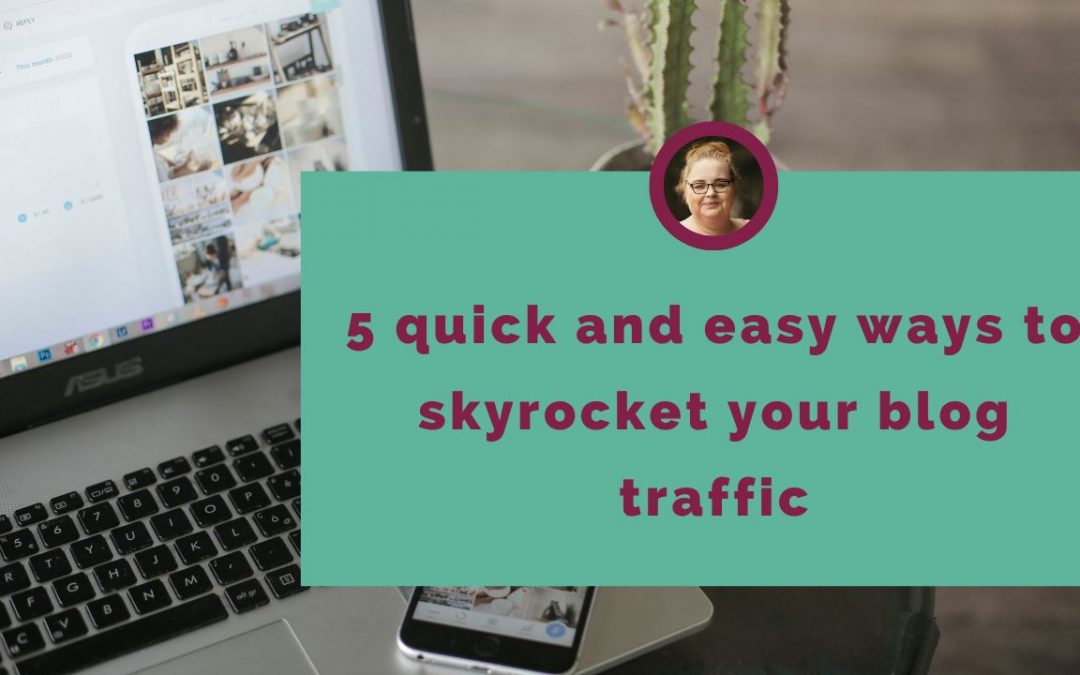As a business owner, I’m sure you regularly hear how beneficial blog traffic is for your business. However, when you’re juggling everything else that comes with running your own business, you don’t want to add another item to your ever-growing to-do list unless it’s actually worth your time.
And regularly blogging can undoubtedly do great things for you. Here are just some of the benefits of blogs:
- Positions you as an industry expert
- Builds know, like, trust with your audience
- It’s always helping drive blog traffic back to your website
- Improves SEO and overall visibility
- It’s an opportunity to show your brands personality
However, for a blog to do all of those things, there are some essential steps you need to take. Unfortunately, it’s not as simple as writing a few words and hoping for the best.
So, I’m going to share my 5 steps to writing a successful blog AND show you my top 10 places you can share it to skyrocket your blog traffic.
Let’s dive in…
Give your audience what they want
With so much content available online, it takes something special to make someone stop scrolling and say, “I need to read that!” And the only way you will do that (without resorting to clickbait) is to make your reader think you are speaking directly to them. By the way, this isn’t just for blogging; this principle should be true for all your marketing. So, once you know exactly who your target audience is, you need to find out what they need to know. An excellent tool for this is AnswerThePublic. You just type in a search term or keyword relevant to your audience, and the site will generate a massive amount of data that you can then use as content ideas.
Another great feature is having a free plan giving you one free daily search. You can also download your results, so one daily search is probably sufficient for most small businesses.
Create a killer headline
While we know getting people to stop and read your content isn’t easy, recent research showed just how challenging it is. 8 out of 10 people will read a headline, but only 2 out of 10 will read the rest of the content. This means your headline has to be irresistible and tell your target audience precisely what problem your content is solving. Fortunately, there is another excellent free tool for this, so you don’t have to try and figure it out yourself. The Headline Studio from CoSchedule gives you unlimited headline analysis, so you can keep tweaking it until you find the ideal headline.
If it can’t be found, why write it?
Search Engine Optimisation, or SEO, is often a term that strikes fear in small business owners. So much information is available online, and it often sounds like another language; however, it doesn’t need to be scary.
SEO is the process of optimising your content to easily be found and understood by search engines and, therefore, shown to your ideal client when they search for a specific word or phrase. Now, I’m not going to go into detail here as it would be an unbelievably long piece; however, again, I have a great free tool that will help you optimise your content. SEO Content Editor allows you to copy and paste or write directly into the editor and will give you suggestions to improve the SEO of your blog. As with all of these tools, the free versions are never as good as premium tools; however, if you are on a budget or just getting started, they are certainly a huge help.
A picture tells a thousand words
While blogging is predominantly about what you write, adding images helps break up the content. It also means when you share your blog, a picture is included and helps draw attention to your content.
So what images should you use? Firstly, they should be relevant to your topic. If you can use original pictures that you have taken, this also helps improve your SEO, as search engines love originality. Infographics also work well for breaking up large pieces of text and making the content more “shareable.”
Just be aware of copyright when using images that aren’t your own. Even some images from sites such as Canva may not be free for you to use, so always do your homework and, if unsure, err on the side of caution.
Share, share, share
So, by now, you’ve written a blog for your audience about a topic that’s important to them, you’ve got a killer headline and some shareable images, and Google can’t wait to share it with the world. So what’s left to do? Well, it’s time to skyrocket your blog traffic and here are my 10 favourite ways to get my blog out into the world…
Your email list
Now, depending on how often you blog, you might not want to send every blog you write. For example, if you blog weekly or more, you could include a snippet of each in a monthly newsletter where people can click a link to read more. If you blog monthly or less, you could send each blog out or do a quarterly round-up. Honestly, the frequency depends on the time you have available and how often your email list likes to hear from you.
Your email signature
The humble email signature is often an untapped resource when sharing anything. And just take a second to think about how many emails you send every day. You can have links to your website, social media channels and even adapt your signature to promote your latest blog.
LinkedIn Articles
You can share your blog directly to LinkedIn; however, LinkedIn has its own article platform and now newsletter that is extremely powerful – LinkedIn Articles. If LinkedIn likes your article, they will promote it to other users, potentially opening up a whole new audience. LinkedIn Articles are searchable on Google and other search engines. And LinkedIn prefers you to use it, as you aren’t driving traffic directly away from the platform like when you link to your blog.
Facebook Page and Profile
This one needs little explanation. Ensure you share your blog to both your personal and business page using a short, punchy caption that entices your followers to want to read more. It’s also essential the images you use are displayed correctly, as this will help grab attention.
Facebook Groups
Like above, if you have your own Facebook Group, you can share your blog there. However, other groups allow you to share your blog on certain days. Now, with anything like this, don’t take advantage and take time to support the group overall.
Social Media Comments
Like my last point above, this has to be done with a degree of tact. However, if done well, it can be extremely powerful. Hopefully, you are a member of groups where your ideal client hangs out, or you know common hashtags that your ideal client uses. If so, take some time to look through posts from your ideal clients, and IF (and only IF) you see a post where you can add value by sharing your blog, then do so.
Let’s use this blog as an example, I published it today, and in 2 weeks, I come across a post on Facebook where someone is struggling to drive traffic back to their website. It would make sense, and add value, that I leave a quick comment and share this blog with them.
This is a great place to drive traffic back to your blog. Create an attention-grabbing image and a teaser caption with a link directly to your blog.
As with Pinterest, create a beautiful image and compelling caption. However, you can only add a link back to your blog when sharing your post to your stories or adding a link in your bio. Instagram only allows one link in your bio, so use a free tool like Linktr.ee to enable more links. Furthermore, be aware that Instagram stories disappear after 24 hours. Remember to add them as a highlight so they continue working for you as long as you want.
Medium
Medium is an excellent platform for writers or anyone who blogs. It’s an open platform to share your writing with other users. There is also a chance your article will get picked up by Medium and shared via their daily newsletter, reaching over 100 million readers.
Typeshare
Typeshare is relatively new, and many writers use it as a portfolio-type platform; however, it’s still worth creating a free account and adding your blog to gain more exposure, increase SEO and drive links back to your website.
BONUS TIP
ASK! That’s right; remember to add a call to action whenever you share your blog. Some common CTA’s you could use are:
- Tag a friend who will find this helpful
- Share with your network
- Send this to any friends that might be interested
So there you go, my top tips for skyrocketing your blog traffic. I hope you found it helpful, and if you have any questions, drop them in the comments; I promise to get back to everyone.
As a Virtual Marketing Assistant specialising in content and copywriting, helping businesses attract and nurture their ideal clients to grow their sales lights me up. Drop me a message today if you need help identifying your perfect client, perfecting your messaging, or marketing your services.
You can also download my FREE guide to make SEO Easy, a handy desktop guide packed with quick and easy tips to get your business found online.
Or
If you’re stuck with where to start with your social media or blogs, I send a FREE email every Sunday with 7 content ideas for the week ahead to help you get those creative juices flowing. You can sign up here.

